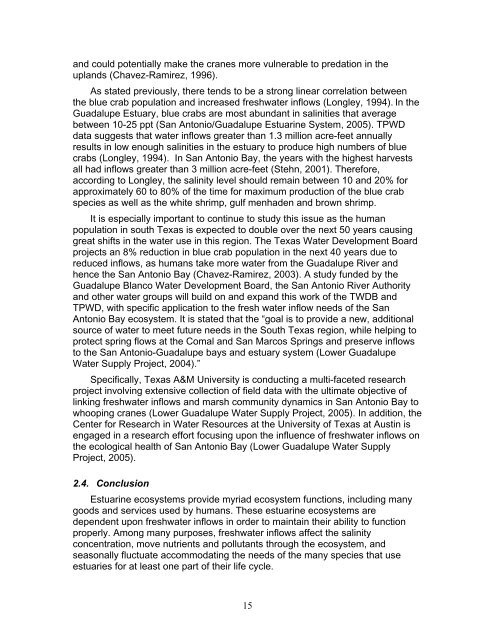The Economic Value of Water and Ecosystem Preservation
The Economic Value of Water and Ecosystem Preservation
The Economic Value of Water and Ecosystem Preservation
Create successful ePaper yourself
Turn your PDF publications into a flip-book with our unique Google optimized e-Paper software.
<strong>and</strong> could potentially make the cranes more vulnerable to predation in the<br />
upl<strong>and</strong>s (Chavez-Ramirez, 1996).<br />
As stated previously, there tends to be a strong linear correlation between<br />
the blue crab population <strong>and</strong> increased freshwater inflows (Longley, 1994). In the<br />
Guadalupe Estuary, blue crabs are most abundant in salinities that average<br />
between 10-25 ppt (San Antonio/Guadalupe Estuarine System, 2005). TPWD<br />
data suggests that water inflows greater than 1.3 million acre-feet annually<br />
results in low enough salinities in the estuary to produce high numbers <strong>of</strong> blue<br />
crabs (Longley, 1994). In San Antonio Bay, the years with the highest harvests<br />
all had inflows greater than 3 million acre-feet (Stehn, 2001). <strong>The</strong>refore,<br />
according to Longley, the salinity level should remain between 10 <strong>and</strong> 20% for<br />
approximately 60 to 80% <strong>of</strong> the time for maximum production <strong>of</strong> the blue crab<br />
species as well as the white shrimp, gulf menhaden <strong>and</strong> brown shrimp.<br />
It is especially important to continue to study this issue as the human<br />
population in south Texas is expected to double over the next 50 years causing<br />
great shifts in the water use in this region. <strong>The</strong> Texas <strong>Water</strong> Development Board<br />
projects an 8% reduction in blue crab population in the next 40 years due to<br />
reduced inflows, as humans take more water from the Guadalupe River <strong>and</strong><br />
hence the San Antonio Bay (Chavez-Ramirez, 2003). A study funded by the<br />
Guadalupe Blanco <strong>Water</strong> Development Board, the San Antonio River Authority<br />
<strong>and</strong> other water groups will build on <strong>and</strong> exp<strong>and</strong> this work <strong>of</strong> the TWDB <strong>and</strong><br />
TPWD, with specific application to the fresh water inflow needs <strong>of</strong> the San<br />
Antonio Bay ecosystem. It is stated that the “goal is to provide a new, additional<br />
source <strong>of</strong> water to meet future needs in the South Texas region, while helping to<br />
protect spring flows at the Comal <strong>and</strong> San Marcos Springs <strong>and</strong> preserve inflows<br />
to the San Antonio-Guadalupe bays <strong>and</strong> estuary system (Lower Guadalupe<br />
<strong>Water</strong> Supply Project, 2004).”<br />
Specifically, Texas A&M University is conducting a multi-faceted research<br />
project involving extensive collection <strong>of</strong> field data with the ultimate objective <strong>of</strong><br />
linking freshwater inflows <strong>and</strong> marsh community dynamics in San Antonio Bay to<br />
whooping cranes (Lower Guadalupe <strong>Water</strong> Supply Project, 2005). In addition, the<br />
Center for Research in <strong>Water</strong> Resources at the University <strong>of</strong> Texas at Austin is<br />
engaged in a research effort focusing upon the influence <strong>of</strong> freshwater inflows on<br />
the ecological health <strong>of</strong> San Antonio Bay (Lower Guadalupe <strong>Water</strong> Supply<br />
Project, 2005).<br />
2.4. Conclusion<br />
Estuarine ecosystems provide myriad ecosystem functions, including many<br />
goods <strong>and</strong> services used by humans. <strong>The</strong>se estuarine ecosystems are<br />
dependent upon freshwater inflows in order to maintain their ability to function<br />
properly. Among many purposes, freshwater inflows affect the salinity<br />
concentration, move nutrients <strong>and</strong> pollutants through the ecosystem, <strong>and</strong><br />
seasonally fluctuate accommodating the needs <strong>of</strong> the many species that use<br />
estuaries for at least one part <strong>of</strong> their life cycle.<br />
15
















